
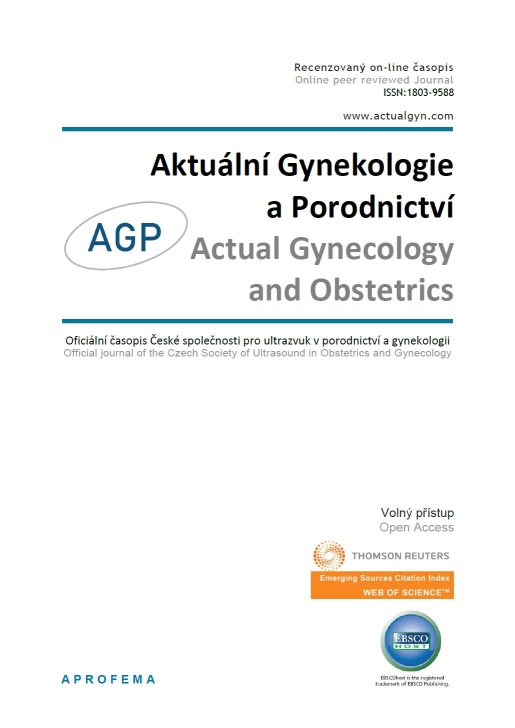










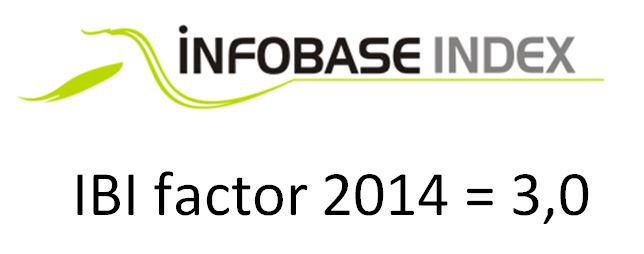 Official publication of the Czech Society of Ultrasound in Obstetrics and Gynecology.
Official publication of the Czech Society of Ultrasound in Obstetrics and Gynecology.

Objectives: Deficiency of folic acid in periconceptional period is a risk factor of congenital malformations including neural tube defects in offspring. Supplementation with folic acid before conception, covering conception and first weeks of pregnancy is the primary prevention of mentioned disorders. The study evaluates knowledge about folic acid and the effects of its deficiency, as well as supplementation of folic acid among female university students in Poland.
Methods: 184 female students from John Paul II University in Biała Podlaska were recruited for this study. The respondents received an anonymous questionnaire with questions about demographics and those regarding knowledge about folic acid and usage of folic acid supplements.
Results: Majority of the participants were aware that supplementation of folic acid by women may be recommended (88%). However lower percentage of the respondents demonstrated knowledge about key aspects related to folic acid – their role in neural tube defects prevention (52%), recommended timing and dose of supplementation (42% and 34%, respectively) and green leafy vegetables as a good source of folates in food (55%). Only 34% of respondents knew recommended dosage of folic acid (0.4 mg). Food supplements with folic acid were taking merely by 12% of surveyed women. Higher awareness regarding to folic acid was observed among students of health sciences and participants aged over 30.
Conclusion: The knowledge about folic acid and its supplementation rate among female students were insufficient. Therefore, education about benefits, timing and proper dosage of folic acid supplements appears to be indispensable among women of childbearing age.
Folic acid (FA) is a water-soluble B-group vitamin, very often used in supplements and as an ingredient added to food products. We can find it in plant and animal products, as a group of compounds known as folates. The main source of folates in diet are raw or short-boiled green leafy vegetables. The significant amounts are also found in fruit and vegetables rich in vitamin C and β-carotene, whole grain products, pulses and nuts. Among animal products, liver, dairy and egg yolk are characterized by high content of the vitamin (1,2).
Deficiency of FA during periconceptional period is a risk factor of neural tube defects (NTDs) and other birth defects in offspring (3-5). NTDs are an important public health problem. Worldwide there are more than 300,000 babies who are born with a neural tube defect each year (6). Total prevalence of NTD equals ~9 per 10,000 in Europe, similar in Poland (7). Numerous scientific evidence from both randomised controlled trials and observational studies has proved the important role of periconceptional FA supplementation in primary prevention of NTDs (4,5,8,9). This is particularly important, because many pregnancies are unplanned. In 2015 – 2019 in Europe unintended pregnancy rate was 36 per 1,000 women of reproductive age (15–49) (10). In the same time in Poland unintended pregnancy rate was 29 per 1,000 women – almost half of all pregnancies (46%) were unplanned (11).
WHO recommends the initiation of the use of FA supplements before pregnancy or as early as possible during pregnancy and then throughout pregnancy in 0.4 mg (400 μg) daily (12). Polish Society of Gynaecologists and Obstetricians also recommends using FA in the same amount as a supplement of balanced, folate-rich diet by women of perinatal age as well as those who are planning pregnancy or are currently pregnant. In the 1st trimester (up to the 12th week of pregnancy), the recommended dose is 0.4 - 0.8 mg daily, while after the 12th week of pregnancy it is 0.6 - 0.8 mg daily. Among women with positive history of NTDs in previous pregnancy, during the pregnancy planning period and during the 1st trimester, the recommended dose is 4 mg daily (13).
The aim of this study was to analyse knowledge about FA and rate of using of food supplements with FA among female students in childbearing age.
The data on knowledge and supplementation of FA were obtained using a questionnaire carried out among women studying at the John Paul II University in Biala Podlaska. The inclusion criterion was female gender and the exclusion criterion was age over 50 years. All questionnaires were collected during the course of study in June 2022. After agreeing written consents to participate, the students received an anonymous questionnaire including three sets of questions. The first set of 9 questions was designed to gather demographic data (age, gender of the participant, country of origin, place of residence, education level, studying faculty and experience of pregnancy), the second set of 9 questions was specifically related to FA knowledge (sources of folates in diet, deficiency effects, appropriate timing and dosage of supplementation) and the third set of 6 questions referred to usage of FA among respondents. The data were gathered from 211 female students (199 Polish and 12 foreign students from Belarus, Ukraine and Russia), studying at 9 faculties. After the exclusion of respondents who never heard about FA and the foreign students, 184 questionnaires were analysed. All data were collected and evaluated in Microsoft Excel.
Average age of the surveyed women was 24,9 ± 5,9 years (20-47 years). The largest percentage of respondents were women aged 30 and younger (84%). Nearly the same percentage of participants lived in the city as in the countryside. The participants were studying health (Dietetics, Physiotherapy, Nursing) and non-medical (National security, Economics, Philology, Finance and accounting, Pedagogy, Tourism and recreation) sciences. The first group accounted for 60% of total respondents. Most of the participants were women without pregnancy experience and who were not planning pregnancy (79% of the respondents). The detailed characteristics of the study population are shown in Table 1.
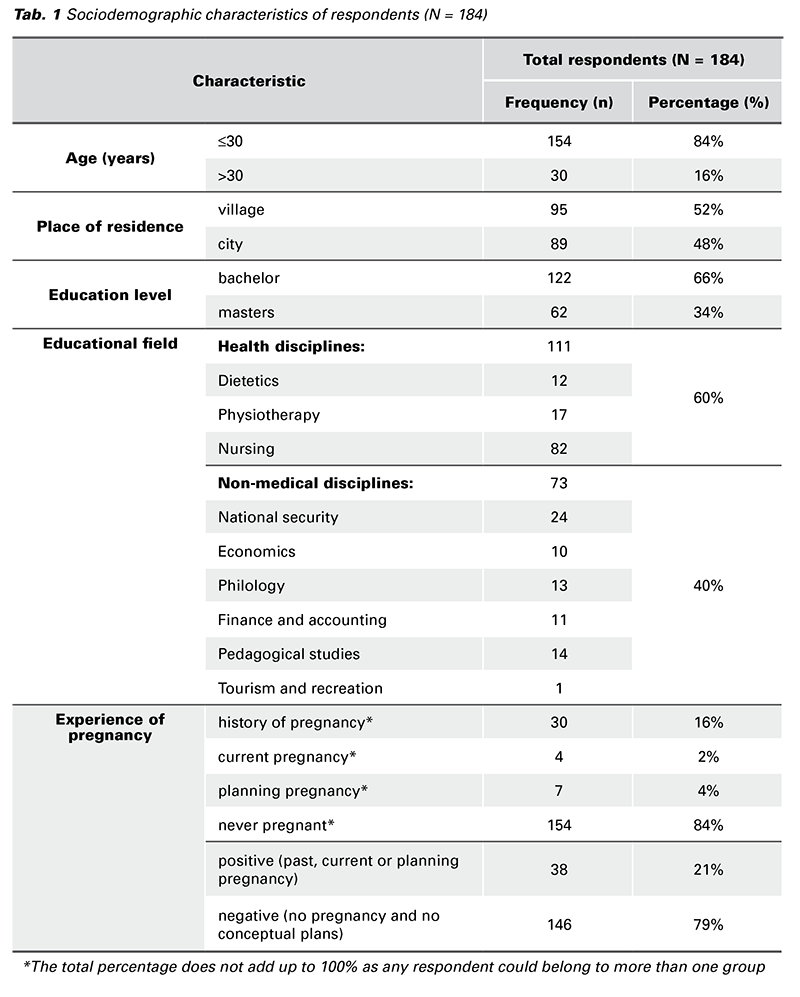
Nearly two-thirds of the respondents indicated the Internet as the main source of knowledge about FA (65%). Most of them were aged 30 and younger (69%), without history of pregnancy and were not planning pregnancy (71%). The second most popular resource for the surveyed women were physicians (34%). It was stated by women over 30 years of age (70%) and those with a positive pregnancy history (79%). Subsequently the participants indicated: family (32%), TV (32%), friends (31%), school education (30%) and other (during studies 1%) as their source of information. The main sources of information about FA among total students presents Figure 1.

Among all respondents, 55% indicated green leafy vegetables as a good source of folates in food. More often this answer was chosen by medical sciences students (62%) compared to those of non-medical fields (44%), and the women with positive (79%) vs. negative experience of pregnancy (49%). Participants aged over 30 pointed green leafy vegetables more often (87% of them) than their younger colleagues (49%). 29% of total respondents were unable to indicate any products rich in folates. The best sources of folates in the diet in opinion of the whole group of surveyed women are shown by Figure 2.
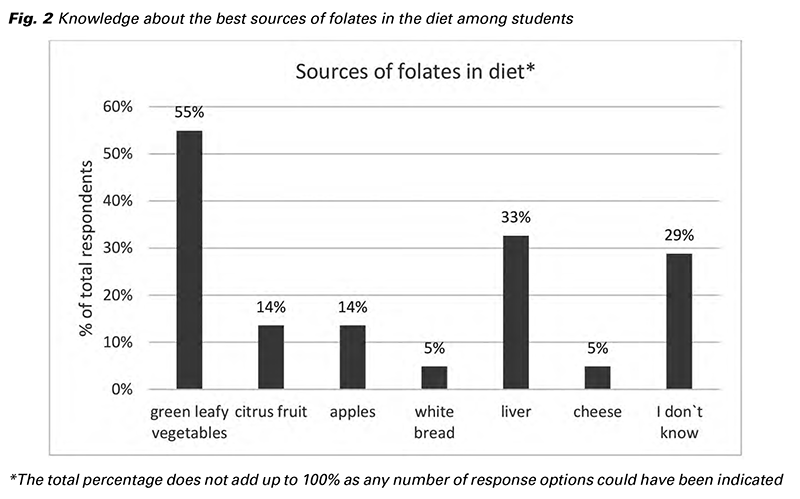
The majority of surveyed students (88%) were aware that supplementation with FA might be recommended for women. However the necessity of periconceptional supplementation was correctly indicated by 42% of the respondents. The participants aged over 30 appeared to have better knowledge than their younger colleagues (53% vs. 40%). The health disciplines students had higher awareness of periconceptional necessity compared to non-medical ones (49% vs. 33%). Near three-fifth (58%) women with positive pregnancy experience knew about the beneficial timing of supplementation, whereas only 38% of students without pregnancy history or any preconceptual plans were aware of this important issue. The knowledge about recommended dose of supplemented FA was demonstrated by 35% of the respondents, while 42% of them did not know current recommendations. Thirty four percent of participants indicated recommended dosage of FA (400 μg) in periconceptional period. Every second medical student gave the correct answer. Only 10% non-medical students knew the recommendations. Among women with positive pregnancy experience, proper dosage was indicated by 47%. Out of the respondents who were never pregnant and had no conceptual plans, correct answer was known by 30%.
Three-fifth of the respondents claimed to have the knowledge about benefits of FA supplementation, wherein 23% knew nothing about the role of this vitamin. Over half of the surveyed women (52%) were familiar with the importance of FA supplementation in prevention of NTDs. Level of knowledge among participants was different in specified subgroups. Among the respondents aged over 30 showed higher awareness compared to participants in younger group (93% vs. 44%). The women studying health specializations chose correct answers more often than non-medical students (66% vs. 30%). Most women with positive pregnancy history compared to respondents without experience of pregnancy indicated the important role of FA in NTDs prevention (84% vs 43%). On-third of total respondents did not know any consequences of folates deficiency during pregnancy. The knowledge of the respondents about FA and the effects of FA deficiency are presented by Table 2 and Figure 3.
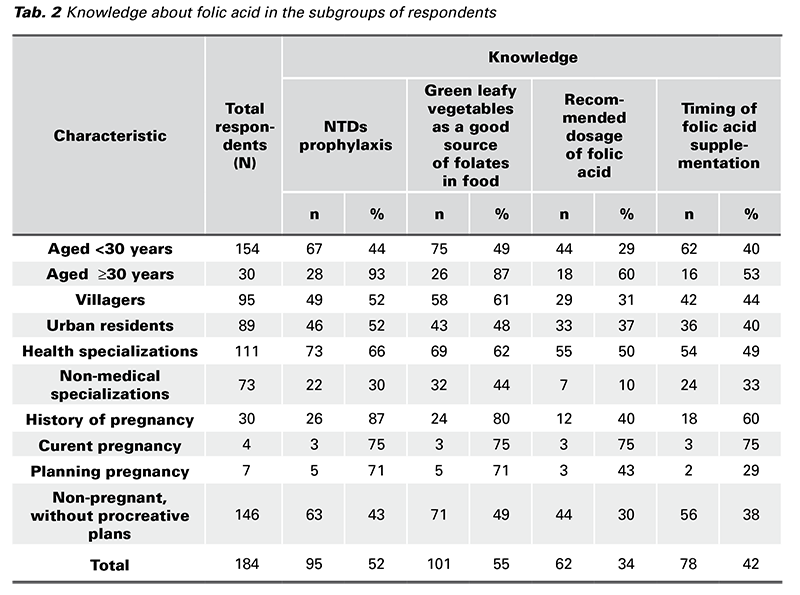
Although the majority of surveyed women considered FA supplementation needful (88%), the same percentage of the respondents (88%) were not taking this vitamin. The intake of FA was declared only by 12% of the participants – more in health disciplines group compared to non-medical ones (15% vs. 7%). Less than three-fourth (71%) of women planning to become pregnant were supplemented with FA. Eighty-two percent of women supplemented
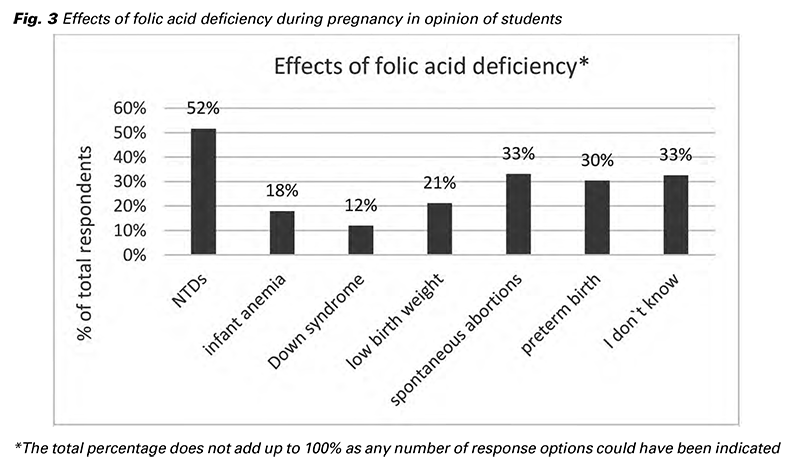
FA daily. Half of them did it on their own initiative, about one-third – on physician’s recommendations and one-fifth because of trying to get pregnant or in case of becoming pregnant. There were not any special reasons among respondents for not using supplementation of FA. Similar percentage of surveyed women indicated following healthy diet as sufficient (28%), quarter of the study group did not pay attention to it and the same amount of the respondents could not give any reasonable explanation for not using FA. The lack of knowledge about recommended dosage as a cause of no intake of FA was mentioned by 27% of the students. Despite this, readiness of usage of FA in case of trying to become pregnant, was declared by 76% of the respondents. The usage of FA in the subgroups of respondents shows Table 3.
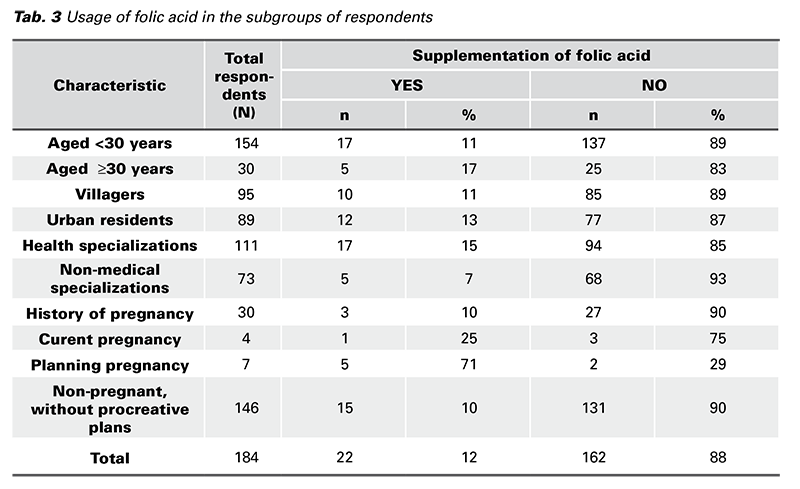
The main source of knowledge about FA among the participants of our study are the Internet and their physicians. Zadarko-Domaradzka et al. (14) in their study carried out among Polish female students, received comparable answers (53% and 27.2% indicated by respondents, respectively). Ehmke vel Emczyńska and Kunachowicz also reported similar results. Every second of their respondents indicated a physician as the source of knowledge about FA (15). In studies conducted in other countries, physician or other health professionals were pointed out as common source of knowledge to a large extent – from 15.7% in Korea to 31.2% in Saudi Arabia and above 90% in Qatar (16-18). On the other hand, medical students in Ukraine pointed their university teachers (65.8%), as the main source of knowledge about FA and NTDs (19).
Over half of our respondents indicated green leafy vegetables as a source of folates. It is worth noting that nearly one-third students were unable to point to any food rich in folates. Zadarko-Domaradzka et al. (14) presented similar results. Their respondents pointed green leafy vegetables, liver and citrus fruit (41.6%, 32.5% and 18.8%, respectively) as a source of folates. 35% of the participants could not indicate the correct answer. In the study of Ehmke vel Emczyńska and Kunachowicz (15), conducted among women of childbearing age without pregnancy experience, including students, the respondents indicated correctly to green leafy vegetables (80%), pulses (66%), nuts and seeds (33%) as a sources of folates. In Cieślik et al. study carried out among Polish women aged 18–45, the participants with higher education more often indicated proper food products (75% pulses, 73% green leaf vegetable, 53% liver) compared to participants with vocational education (65%, 64%, 43%, respectively) (20). In the Ukrainian survey conducted among fourth and fifth year’s students of the Faculty of Medicine (76.3% of women and 23.7% of men), 95.6% of participants correctly indicated to at least one folate-rich product (19). Leafy green vegetables as source of folates were indicated by 57% of Ukrainian students (19). In the study among female students in Saudi Arabia (17), folate-rich products were pointed out by 59,7% of respondents. Moreover, health science specialization was related to correct knowledge about natural sources of FA (p < 0.008) (17).
In our study above half of the surveyed women knew of the importance of FA in periconceptional period. In the research of Zadarko-Domaradzka et al. (14) 40.6% of respondents knew of the importance of this vitamin in the prevention of NTDs, but slightly more of them (43%) did not know anything about the role of folates. In comparison, 86.8% of Ukrainian medical students were aware of the role of FA in NTDs prophylaxis (19). In our study, over twice more health disciplines students pointed to NTDs as the effect of insufficient delivery of FA, in comparison to non-medical students. In the research conducted twice in Lodz among Polish female students from three universities (Medical University of Lodz, Technical University of Lodz and the University of Lodz), the knowledge about NTD prophylaxis was more common and constant among medical students compared to non-medical ones (92.1% vs. 38%, p < 0.001 in 2008 and 93.3% vs. 57.1%, p < 0.001 in 2013) (21).
Low awareness of supplementation of FA and NTDs risk among European women was shown by a large survey conducted among participants aged 15–49 from 18 countries. Two-fifths of the respondents stated that they had known about the benefits of FA prophylaxis, but only 17% knew that FA could reduce the risk of NTDs. Among teenage participants it was 15% and 3%, respectively. Compared to European countries the highest rates of awareness were found in Poland and the UK (> 90%). Among Polish women, three-fourth of them knew the benefits of FA and 36% of them were familiar with the role of FA in prevention of NTDs. Total respondents in age range 30-34 demonstrated higher awareness about FA (77%) and better knowledge of its benefits (49%). The highest percentage of women being familiar with prophylaxis role of FA in NTDs were in the groups aged 30-34 and 35-39 (22%, the same in both) (22). Among our participants, women aged over 30 presented more than twice higher awareness, compared to their younger colleagues (93% vs. 44%). Similarly, in Saudi Arabia, the female students over 30 years of age had significantly higher awareness than the younger participants (17). Education level (bachelor and above) was positively associated with in-depth knowledge of the association of FA deficiency with NTDs (17).
Similar to ours findings, the results from two other studies conducted among Polish women have shown lower awareness of preconceptional supplementation of FA. Among female students from the Podkarpackie Voivodeship, supplementation of FA while planning a pregnancy declared 52.4% of them. Marely 8.9% of the respondents knew the recommended dose (14). In Górniaczyk et al. study (23) conducted among pregnant women aged 16-40 years, only 54% of them supplemented FA preconceptionally, although pregnancy planned 71% of them. More often FA user were women with higher education compared to primary or secondary education (62% vs. 35%) (23).
Most of surveyed women in childbearing age from different studies did not take any FA food supplements. In Zadarko-Domaradzka et al. study (14) a total of 86.1% respondents did not supplement FA. Among participants who used FA, 65.3% did it daily. The causes of non-using FA were both lack knowledge about FA (20.8%) and not being aware of the benefits of its supplementation (25.7%). Over half of the respondents considered supplementation of this vitamin as unnecessary (14). In the European survey (22) the women reported deficient advise (43%) and lack of knowledge (40%) as the reasons for not taking FA during pregnant or trying to become pregnant. Marely 37% of them had taken FA at some point, 7% of the respondents took FA during the study. Among women currently trying to become pregnant and who were already pregnant, FA was taken at the time of the survey by 28% and 55% of them, respectively. Adherence to folates supplementation was reported to be low. Only 56% surveyed women while trying to become pregnant and 63% being pregnant, did it regularly (22). Among medical students in Ukraine only 10.3% of 87 surveyed women declared using synthetic FA regularly (19). On the other hand 41.7% of female students in Saudi Arabia used FA (17). Supplementation of this vitamin was reported by 61.1% women with ongoing pregnancy and 44.4% of those who were planning pregnancy (17). The recommended dosage and correct timing of FA supplementation to prevent NTDs knew 57.3% and 47.4% of the respondents, respectively (17). In turn among the surveyed female teachers in Qatar, 34.6% of them could indicate the best time to take FA (18). Over half (52.5%) of respondents were taking FA during the study, 74.5% have ever taken FA. In case of supplementation, at some point in time, 55.4% women took it daily. This study showed statistically significant relationship (p < 0.05) between knowledge about FA and being a current user. The high awareness was related to usage of FA food supplements (18). Similar results received in the study conducted among Korean female students and employees from two universities (16). The respondents knowing FA role in birth defects prevention and appropriate timing intake were more likely to supplement themselves, compared to participants without this knowledge (22.8% and 5.2%) (16).
Interesting conclusions were provided by the study conducted among female students and graduates of universities in Lodz in Poland. Supplements with FA prior conception were taken by 53.3% graduates of medical faculties and 45% graduates of non-medical faculties (21). During pregnancy FA was supplemented by 100% and 83.3% of them, respectively. Female doctors who worked in the centre of NTDs treatment used FA with no exception, if the pregnancy started after they had begun to work in the centre. If the pregnancy started before the employment, only 37.5% of the staff supplemented FA prior conception (21). On the other hand, an evaluation carried out in Poland among women at high risk of developing of fetal anomalies, provided unsatisfactory results. Only 50% of the women with a history of fetal defects confirmed taking of FA supplementation before pregnancy and 62.2% of them did it during pregnancy (24).
The study sample is non-representative of the Polish women of childbearing age, as participants were female students, enrolled from the single university. The data was collected by the participants are based on selfreporting which can lead to misclassification of outcomes.
Considering key aspects regarding to knowledge about FA, inclusive a good source of folates in food, role of FA food supplements in the prevention of NTDs and recommended dosage and timing of supplementation, awareness among our respondents were insufficient. In according to recommendation of using FA for women in childbearing age, supplementation rate among participants was also disappointing. The findings from own and other studies confirm that the knowledge about FA is not always related to correct supplementation of this vitamin. However field and level of education have influence on awareness and usage of FA. Therefore it is important to disseminate practical advice on the dose and benefits of supplementation of FA, especially for women without higher education or with non-medical education. Healthcare system professionals should develop methods to reach, with reliable sources of knowledge about FA and the role of this vitamin in prophylaxis of NTDs, to a large percentage of women. Summarizing, continuous education about benefits, timing and proper dosage of FA food supplements is necessary among women of childbearing age.